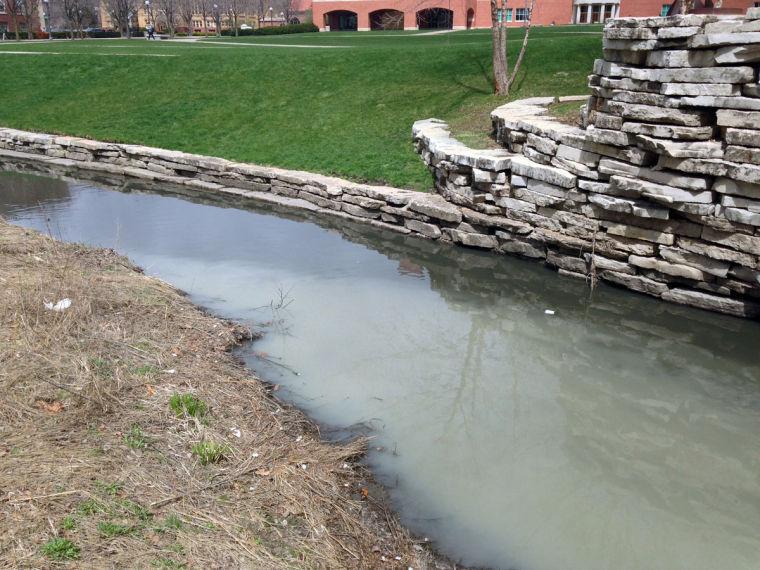Unknown white pollutant spotted in Boneyard Creek
April 29, 2014
It was a Friday; the sun was blaring over the Bardeen Quad as a group of students threw a football around, but then it landed in the middle of Boneyard Creek.
After the group spent a few minutes grappling at the air, one girl started to roll up her jeans. But before she got the chance to jump in the shallow waters, the wind brought the ball back to the bank.
As it turns out, the wind saved her from more than just wet jeans.
On April 15, just three days earlier, a cloud of white pollutants moved downstream from Champaign, said Alex Nagy, civil engineer for Champaign Public Works. He called the event a “discharge.”
“By the time we got there, it had gone down the channel. We tracked it upstream, but lost the trail of it,” he said. “We did find a shock vac in an ally with some residual white stuff in it, but we were unable to catch anyone in the act of doing it on Tuesday. So the trail went cold.”
Get The Daily Illini in your inbox!
Although they don’t know what it was that snaked through the creek on April 15, Nagy said the most common discharges tend to be paint, construction materials and chemicals that get sent down storm water inlets.
“A lot of times, people think their waste goes to a treatment plant, instead of directly to a creek. That’s why a lot of the inlets you see around the city have ‘dump no waste’ medallions on them,” Nagy said.
But, whoever discharges may not know what they are doing is illegal, said Eliana Brown, Environmental Compliance coordinator for the University.
From his office window in the Mechanical Engineering Building, Professor Emeritus of Engineering Clark Bullard saw the trail of white in the creek and reported it to Brown and Nagy. And it’s not the first time he’s noticed something like it.
“In the 1960s, when I was a student here, the creek would be a different color every day. Anything from slimy green to red and rust colored. There was no EPA,” he said. “There were dozens and dozens of pipes coming out of University buildings and labs putting all kinds of pollutants in.”
When the Clean Water Act was passed in 1972, the EPA was created. And with the help from the University’s Facilities and Services and Champaign’s Public Works, the Boneyard Creek was made habitable, and over time, most of these pipes were closed off.
Brown said the University’s Illicit Discharge Detection and Elimination program has been in place for 10 years and tracks down these pipes. The team has gone to over 300 University buildings and has looked at a little over 17,000 drains and sump pumps to make sure they’re being plumbed correctly.
“We do find ones that are plumbed incorrectly, and what we do is plug those or reroute them,” she said. “We had a priority setup so that we looked at sources that had the potential to cause the most harm to the Boneyard, say buildings with chemicals in them.”
Bullard has kept a coffee-stained note of the 19 different species of animals he has seen come back to the Boneyard since the ‘60s, but even though the creek has gotten better since those days, he says more needs to be done to protect the Boneyard’s habitat from discharges.
As of now, in the event of a discharge, Illinois EPA delegates Brown or Nagy to address the issue. If they find whoever is discharging, they will talk to them and have them correct it.
“I would say (that works) almost 100 percent of the time. People will comply and correct whatever it is that they’re doing and prevent it in the future,” Nagy said, adding that his and Brown’s offices can employ several different kinds of punishments, like fines, if there is no compliance.
“Alex goes out and he talks to them and he listens to their story and they say they won’t do it again and it happens again, because it’s a different contractor this time,” Bullard said. “The mantra with EPA is ‘we don’t want to punish people, we just want to improve water quality, and if talking to them nicely will do that, then that’s what we’ll do.’”
He said that there needs to be fines big enough that it’s not seen as a business expense.
“Right now, nobody has an economic incentive to do the right thing,” he added.
Austin can be reached at [email protected] or @austinkeating3.







